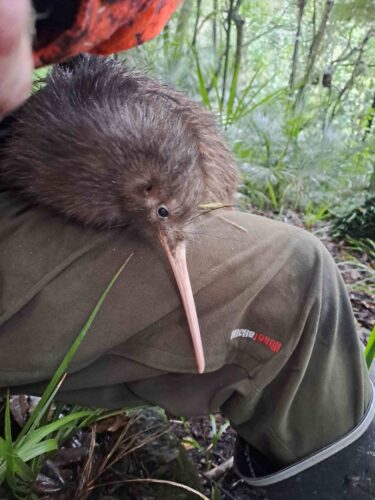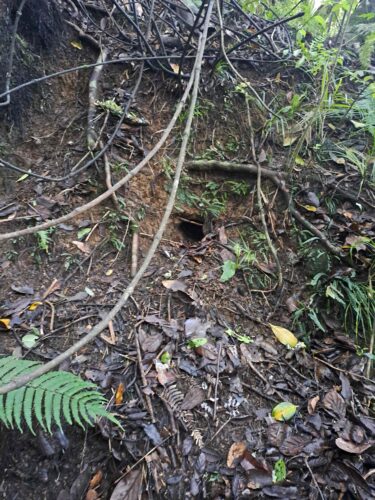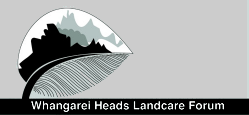2025 – July Report
The Whangarei Heads Kiwi Population Estimate for 2025 is 1,330
Thank you kiwi counters! With the wet autumn following a dry summer the kiwi were certainly calling hard during the counting period. There were some calm patches of weather and all but one of the 19 sites got 8 hours of listening done so we got a reasonable measure of the effectiveness of the Kiwi Recovery work being done at the Heads. The long term results show that good stoat control, through quality trapping and Kiwi saver (1080) pulses, is giving good kiwi chick survival and above all else it shows responsible dog control by the vast majority of our community.
Thank you to all the hard work kiwi counters for braving the cold, listening hard and doing the paperwork accurately -mostly- the reward of chocolate, beer or wine seems to have improved the accuracy of data recording for some! Without your efforts we would not know what was happening with our kiwi population.


Overall the counting gave an approximate kiwi population of 1,330 compared with 1,185 last season and 80 back in 2001.
In terms of the number of calls, 150 hours of listening at 19 sites recorded 1,850 calls at a call rate of 12.3 calls/hour. This is up from 10.3 calls/hour last year.
Some kiwi call more than others so we try to work out the actual number of individual kiwi. Over 4 nights the listeners get a good idea of the locations of the breeding pairs and using a sheet recording these locations we are able to work out the number of actual kiwi at each site. Human ears are needed for this, the KLDs (Kiwi Listening Devices) only count call number not direction. So if a KLD is used we use the estimated kiwi numbers from the previous human count (numbers shown in italics in the summary sheet) in our population estimate.
The number of individual kiwi counted was 266 males and 102 females compared with 237 males and 107 females in 2024 (Kiwi listening does not pick up all the female kiwi because they call less often and are harder to hear due to a deeper call note than the high pitched males).
Using our usual simple model of 40% of the kiwi habitat at Whangarei Heads being covered by listening stations and assuming a 1:1 sex ratio that comes out at: 266 males X 2.5 X 2 = 1,330 estimated adult population.
So both our call rate and the number of individual kiwi counted are up.
As young kiwi are slow growing and take two or more years to get to calling age there should be even more kiwi out there.
With the number of kiwi increasing it is getting more difficult to determine the actual number of kiwi present at some sites as the calls are often close together and may be one kiwi moving or two close together- a good problem to have.
There are also more kiwi showing up north of the Heads in the Parua Bay and the “Kiwi Link” area where call counts are increasing (in areas where dogs are controlled), many of these will be kiwi walking out of the Whangarei Heads peninsula area and finding new territories – this is great news for wider kiwi recovery!
Thank you everyone for the huge team effort.
Attached are:
- Summary of this year’s listening for each station giving M and F calls, and the actual number of M and F kiwi estimated at each site by using the directional sheets.
- Summary of average call counts for all sites from 2002 to 2025. Check out the trends at your place.
Two more Road killed kiwi
A sad by-product of the increased kiwi population and the increased road traffic at the Heads are road killed kiwi. Two more this month:
- 10/7/25 An adult female (youngish) , no ID chip, 130.4mm and 1950g usual area between McLeods and Nook turn off
- 24/7/25 A sub-adult, no ID chip, 98.5mm and 1500g, at the western end of McLeods.
As usual these are wild hatched and grown kiwi, another good indicator of the effective stoat and dog control in the area.
Upcoming Whangarei Heads Landcare Forum Event:
“Snapshots of Landcare” – Stories from the Heads
The WHLF team work hard behind the scenes and the committee has organised an afternoon event with local presenters on Sunday 24 August at the Whangarei Heads School. Starts at 4pm with food and refreshments to follow. See attached invite for more details.
What your monitored kiwi have been up to for July 2025
Nesting is now well underway with dads sitting on nests for 70-100 days with only short breaks each night.
Whangarei Heads/Parua Bay Radio monitored kiwi:–
- Chookie– In his usual area below Owhiwa road. He is nesting in the base of the same hollow puriri that he nested in back in 2001. He was 27 days nesting on 26/7/25 and had a good low 150 minutes of activity. (see pic)
- Teina– In his usual valley of pampas and pines at the north end of Martins’ pine block. Still high 11.5 hours activity and no sign of nesting.
- Beach Girl – In the scrub at the southern end of the Halses’ block at the end of Ross Road. 11.5 hours activity.
- Murdoch –In a nest burrow under a big pine tree, in the native on Deb’s block, at the end of Owhiwha Road. Similar area to last year. 18 days nesting on 22/7/25 with 4 hours activity.
- Humphries – He is nesting in a pampas bush in the pines. North side of Martins’ block Owhiwa Road. 16 days nesting on 27/7/25. Good low 160 minutes activity.
- Wally –His channel 7 transmitter has had almost continuous, loud, radio interference but I managed to check him in a brief break in the interference. He is nesting in a pamas bush in his usual nest area of pines and gum trees at the end of Campbell road, 15 days nesting on 9/7/25 with a good low 3 hours of activity. (see pic)


Released 23/3/25 at Parua Bay
- Myra– 3.5 year old female. She is still settled in the middle of the Martins’ block Owhiwa Road. 13 hours of nightly activity.
- Ping– Young female. She continues to cruise the area at the NW end of the Martins’ pine block. 12 hours of activity.
- Kim –2.5 year old female. Still hasn’t moved far from her release spot in the pampas and pines below Owhiwa Road. Her activity is 12 hours.
Kiwi that have walked to the Whareora Landcare area
- Te Motu Manu Hine – She is still settled in her usual area of the NRC pines behind the Money Factory. 11 hours activity.
Purua Operation Nest Chick (ONC) dads
These are the dads we get chicks from for transfer to Matakohe/Limestone Island.
Nesting is well underway with 6 nesting so far:
- Moondust – 12 hours activity. Usual area behind Lovell’s Irvine road woolshed. He is due for his tx removal but is still playing hard to get in deep burrows. 10.5 hours activity.
- Buddha – Usual area in the paddock north of McGraths’ quarry. 11.5 hours of activity.
- Macio – South Purua reserve, in a nest burrow close to the creek above Johnny’s (one of our original dads back in 2003) old burrow. 33 days nesting on 18/7/25. 3.5 hours activity. (see pic)
- Otiria – South end of the Purua Reserve. Finally caught up with him to remove his transmitter as he has had 3 years of not breeding. He was a fat 2250g and 108.5mm. 12 hours of nightly activity. (see pic)
- 64 – Nesting in a very old rotten log 80m in from Purua Reserve SW boundary fence. Nesting 48 days on 18/7/25. 7 hours activity- which is higher than usual and may mean that his nest is failing.
- Tahi– On the South-eastern side of the Purua reserve, behind Alisons’ farm. Nesting 14 days on 18/7/25. 4 hours activity.
- Sam – SW Purua reserve. 50m in from the Hawkins’ fenceline. Nesting in a supple jack tangle. 14 days nesting on 18/7/25, 4.5 hours activity. .
- Derek – on “Stump” Ridge, South-East Purua reserve. 12.5 hours of activity.
- Fletcher – Usual area behind Lovells’ airstrip. 10.5 hours nightly activity.
- Rua – At the back of Alisons’ farm. Nesting 33 days on 18/7/25. 4.5 hours activity.
- Erima – in the stand of native on Hawkins’ hill. 11.5 hours of activity.
- Prime – in native on the steep southern face near the top of Hawkins’ hill. In a nest burrow, nesting 14 days on 18/7/25. 4.5 hours of activity.
- Purua– North of Hawkins’ hill, 11.5 hours activity.
Trapping/ toxin pulses
July catches: Stoats 0, Weasels 8, Feral cats 1, Rats 118, Hedgehogs 2, Possums 2.
Cheers Todd
Todd Hamilton
Backyard Kiwi Project Manager
Whangarei Heads Landcare Forum
M 021 1145 385












